 There are few masonry repairs that get more expensive than the repair of deteriorating brick paving. It used to be that tradesmen knew how to build things that would last… for decades or maybe even a century or two. Today there are still a few of these old timers around that have the knowledge and the ability to build things that ‘will last’ but for the most part, complicated and knowledgeable installations are a thing of the past.
There are few masonry repairs that get more expensive than the repair of deteriorating brick paving. It used to be that tradesmen knew how to build things that would last… for decades or maybe even a century or two. Today there are still a few of these old timers around that have the knowledge and the ability to build things that ‘will last’ but for the most part, complicated and knowledgeable installations are a thing of the past.
The home you live in today is likely to have been build by young and inexperienced illegal workers, by drunken hillbillies or laid off factory workers – looking to make a few bucks while collecting their unemployment benefits.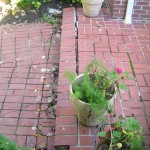
The point being is this; that none of these workers ever had or ever wanted to have, a concern about what happens to your home or the work they perform on it.
Once their job was completed and they had been paid, the illegals went to places south of the border, the hillbillies to the bars and the factory workers back to their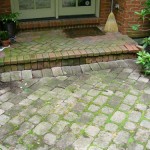 assembly lines. (the first two photos show how all the joints are falling)
assembly lines. (the first two photos show how all the joints are falling)
If you have a home built after 1975 the chances are your brick paving was installed by one of these types of workers. The problem with their installations 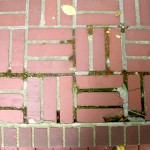 was this; they were usually done with sub-par building materials which were installed with inferior workmanship.
was this; they were usually done with sub-par building materials which were installed with inferior workmanship.
You could argue that this is just the way it is in America in order for ordinary people to have homes they can afford to live in and you would have a good point. (when grass and moss is growing in the joint then the joints are filled with organic materials which is not good)
Unfortunately, trying to repair brick paving that was constructed haphazardly to begin with can be a daunting task, a lot of work and expensive as the result.
Here a few of the reasons why this is so:
-
The use of the wrong brick materials for a paving application means that the mortar joints are excessively large to adjust for the varying sizes which lets in huge amounts of water through the joints. This is not
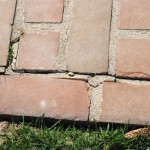 something you can change. Any repair you undertake will effectively be doomed to eventual failure because the design was poor. Nothing can fix a bad design except replacement. The most that you can hope for is a repair that will help to slow the deterioration process down but essentially you still have what was there before. (the photo on the right shows that the edge brick was layed without solid bearing. It is likely overhanging the slab below and when walked upon, tilts a little eventually breaking the joint and allowing more water to enter under the brick.)
something you can change. Any repair you undertake will effectively be doomed to eventual failure because the design was poor. Nothing can fix a bad design except replacement. The most that you can hope for is a repair that will help to slow the deterioration process down but essentially you still have what was there before. (the photo on the right shows that the edge brick was layed without solid bearing. It is likely overhanging the slab below and when walked upon, tilts a little eventually breaking the joint and allowing more water to enter under the brick.)
-
Improper bonding with the substrate. Since most brick paving is de-laminated from the concrete substrate, all the water that collects and leaks in through the large joints, pools under the brick pavers and freezes. This forces the bricks to separate even further from the substrate which creates more cracks and voids for more water entry and the cycle keeps repeating itself. Again not easily fixed. (builders will never give you what you need to do the job right. Here you see the brick sliding off the side of the substrate as the builder poured the concrete base to small to support the bricks)
- Use of the wrong mortar. With any type of paving everything has to be extremely tight and water proofed as much as possible without compromising the elegant and natural beauty of the paving product. To achieve this an installer must be used who is seasoned and understands the proper applications of the paving process. The workers described above never see the failure of their workmanship and likely as not – do they really care? It wasn’t their ‘real’ trade anyway.
-
Improper tooling sequence. One of the most important factors in maintaining a water repellent joint is masonry construction is
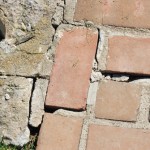 the tooling of the mortar between the bricks and the sequence in which this occurs. The workers used to construct homes would not know this as it takes someone who has an interest in what they do to ‘learn’ the proper procedures of their trade. (again limited damage along the edge which is easily repaired)
the tooling of the mortar between the bricks and the sequence in which this occurs. The workers used to construct homes would not know this as it takes someone who has an interest in what they do to ‘learn’ the proper procedures of their trade. (again limited damage along the edge which is easily repaired)
The list could go on but I have touched on the most important factors to give you a better insight into the paving process. The whole point of my article is to explain to you, the homeowner, why brick paving repair can be so expensive.
Suffice it to say that properly installed brick paving is one of the most demanding, accurate and least tolerant of defects of most masonry products and requires a seasoned pro for the installation process.
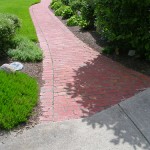 When you wish to have your paving repaired and you want someone to address the problems your particular paving installation is experiencing, be very specific with your contractor about what your goals are and a budget range you wish to stay in.
When you wish to have your paving repaired and you want someone to address the problems your particular paving installation is experiencing, be very specific with your contractor about what your goals are and a budget range you wish to stay in.
Don’t make him guess as he doesn’t have time to price things 5 different ways for you… unless your paying him for that service. (great example of 25 yr old paving that is in great shape but even now the owner should have holes filled every year and a sealer applied every three years to prolong its’ useful life)
And please, please please… DON’T say to your contractor what I have heard all to frequently over the years “You’re the expert… you tell me what’s wrong!”
That is condescending and inappropriate and likely get you an higher repair estimate than what you desire.







































